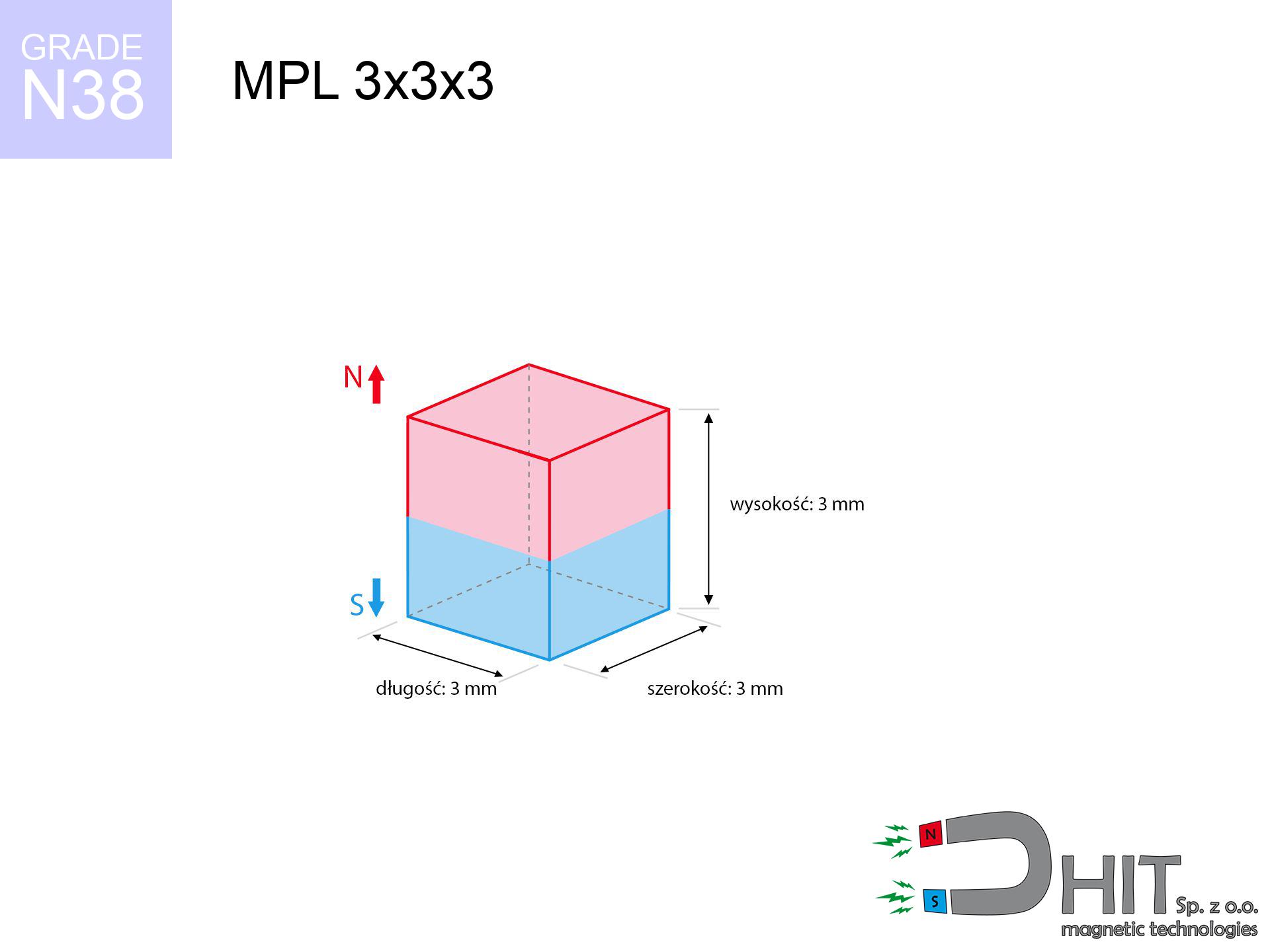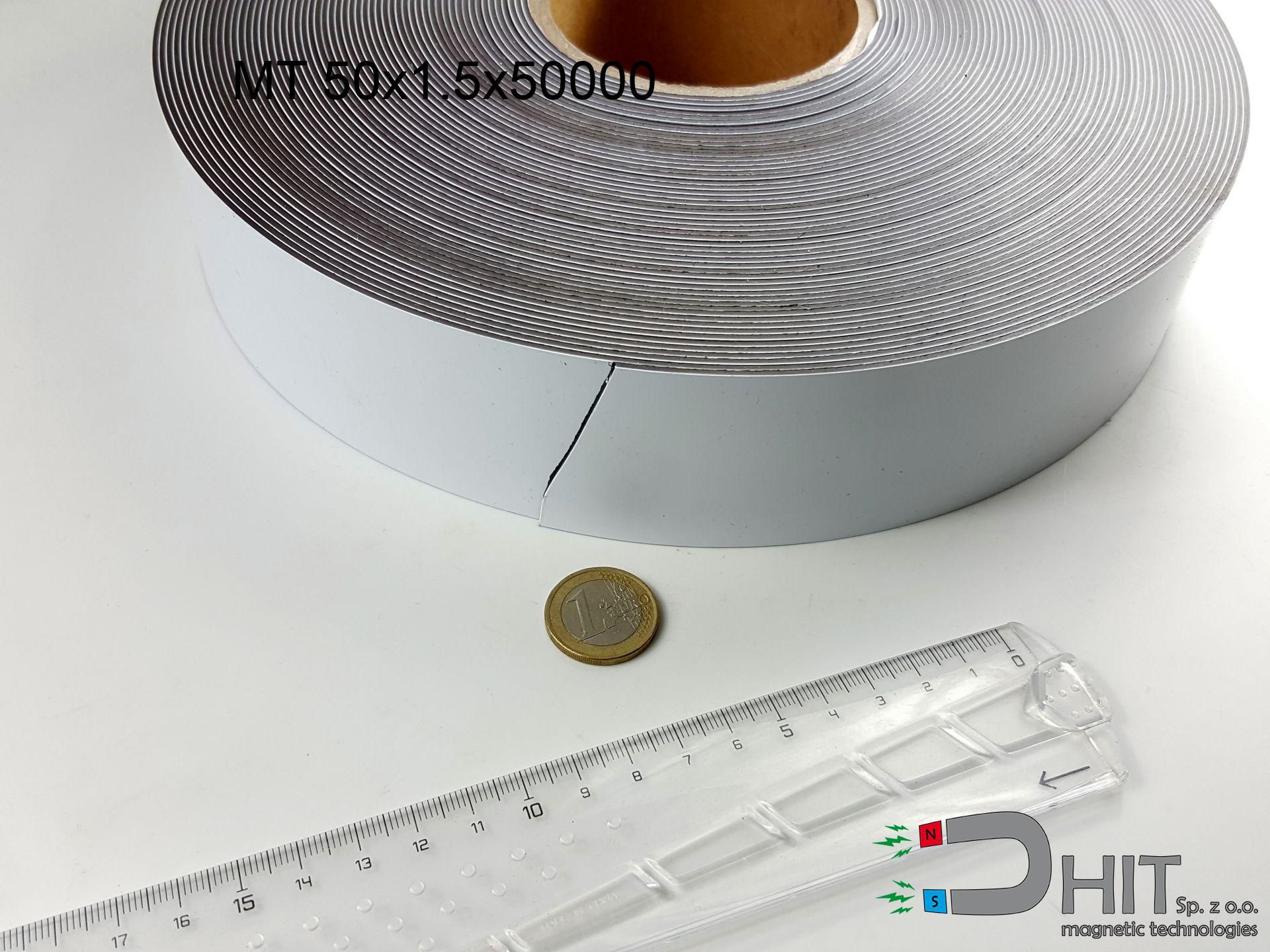MPL 3x3x3 / N38 - lamellar magnet
lamellar magnet
Catalog no 020148
GTIN: 5906301811541
length [±0,1 mm]
3 mm
Width [±0,1 mm]
3 mm
Height [±0,1 mm]
3 mm
Weight
0.2 g
Magnetization Direction
↑ axial
Load capacity
0.71 kg / 6.96 N
Magnetic Induction
538.48 mT
Coating
[NiCuNi] nickel
0.1845 ZŁ with VAT / pcs + price for transport
0.1500 ZŁ net + 23% VAT / pcs
bulk discounts:
Need more?Can't decide what to choose?
Call us
+48 22 499 98 98
if you prefer drop us a message by means of
inquiry form
the contact page.
Strength along with form of magnets can be analyzed with our
magnetic mass calculator.
Orders submitted before 14:00 will be dispatched today!
MPL 3x3x3 / N38 - lamellar magnet
Magnetic properties of material N38
Physical properties of NdFeB
Shopping tips
Advantages as well as disadvantages of neodymium magnets NdFeB.
In addition to their remarkable field intensity, neodymium magnets offer the following advantages:
- They do not lose their magnetism, even after nearly 10 years – the reduction of power is only ~1% (theoretically),
- They show exceptional resistance to demagnetization from external field exposure,
- Thanks to the polished finish and nickel coating, they have an aesthetic appearance,
- They have extremely strong magnetic induction on the surface of the magnet,
- They are suitable for high-temperature applications, operating effectively at 230°C+ due to advanced heat resistance and form-specific properties,
- With the option for tailored forming and precise design, these magnets can be produced in multiple shapes and sizes, greatly improving engineering flexibility,
- Important function in new technology industries – they serve a purpose in HDDs, electric drives, medical equipment or even other advanced devices,
- Relatively small size with high magnetic force – neodymium magnets offer strong power in compact dimensions, which makes them useful in compact constructions
Disadvantages of rare earth magnets:
- They can break when subjected to a sudden impact. If the magnets are exposed to external force, we recommend in a steel housing. The steel housing, in the form of a holder, protects the magnet from breakage and additionally increases its overall resistance,
- High temperatures may significantly reduce the strength of neodymium magnets. Typically, above 80°C, they experience permanent weakening in performance (depending on height). To prevent this, we offer heat-resistant magnets marked [AH], capable of working up to 230°C, which makes them perfect for high-temperature use,
- Due to corrosion risk in humid conditions, it is wise to use sealed magnets made of rubber for outdoor use,
- Using a cover – such as a magnetic holder – is advised due to the challenges in manufacturing fine shapes directly in the magnet,
- Possible threat related to magnet particles may arise, in case of ingestion, which is important in the family environments. Moreover, small elements from these products have the potential to hinder health screening if inside the body,
- High unit cost – neodymium magnets are costlier than other types of magnets (e.g., ferrite), which can restrict large-scale applications
Maximum holding power of the magnet – what it depends on?
The given holding capacity of the magnet represents the highest holding force, assessed in ideal conditions, namely:
- with mild steel, serving as a magnetic flux conductor
- with a thickness of minimum 10 mm
- with a refined outer layer
- with zero air gap
- in a perpendicular direction of force
- under standard ambient temperature
Determinants of lifting force in real conditions
Practical lifting force is dependent on factors, by priority:
- Air gap between the magnet and the plate, because even a very small distance (e.g. 0.5 mm) can cause a drop in lifting force of up to 50%.
- Direction of applied force, because the maximum lifting capacity is achieved under perpendicular application. The force required to slide the magnet along the plate is usually several times lower.
- Thickness of the plate, as a plate that is too thin causes part of the magnetic flux not to be used and to remain wasted in the air.
- Material of the plate, because higher carbon content lowers holding force, while higher iron content increases it. The best choice is steel with high magnetic permeability and high saturation induction.
- Surface of the plate, because the more smooth and polished it is, the better the contact and consequently the greater the magnetic saturation.
- Operating temperature, since all permanent magnets have a negative temperature coefficient. This means that at high temperatures they are weaker, while at sub-zero temperatures they become slightly stronger.
* Holding force was measured on a smooth steel plate of 20 mm thickness, when the force acted perpendicularly, whereas under attempts to slide the magnet the load capacity is reduced by as much as 5 times. In addition, even a slight gap {between} the magnet and the plate lowers the holding force.
Precautions
The magnet coating is made of nickel, so be cautious if you have an allergy.
Studies clearly indicate a small percentage of people who suffer from metal allergies such as nickel. An allergic reaction often manifests as skin redness and rash. If you have a nickel allergy, you can try wearing gloves or simply avoid direct contact with nickel-plated neodymium magnets.
Neodymium magnets are not recommended for people with pacemakers.
In the case of neodymium magnets, there is a strong magnetic field. As a result, it interferes with the operation of a heart pacemaker. However, if the magnetic field does not affect the device, it can damage its components or deactivate the device when it is in a magnetic field.
Neodymium magnets can attract to each other due to their immense internal force, causing the skin and other body parts to get pinched and resulting in significant swellings.
In the case of placing a finger in the path of a neodymium magnet, in such a case, a cut or a fracture may occur.
Keep neodymium magnets away from TV, wallet, and computer HDD.
Neodymium magnets generate strong magnetic fields that can destroy magnetic media such as floppy disks, video tapes, HDDs, credit cards, magnetic ID cards, cassette tapes, etc. devices. They can also destroy videos, televisions, CRT computer monitors. Do not forget to keep neodymium magnets at a safe distance from these electronic devices.
Dust and powder from neodymium magnets are flammable.
Do not attempt to drill into neodymium magnets. Mechanical processing is also not recommended. If the magnet is crushed into fine powder or dust, it becomes highly flammable.
Comparing neodymium magnets to ferrite magnets (found in speakers), they are 10 times more powerful, and their strength can surprise you.
Make sure to review all the information we have provided. This will help you avoid harm to your body and damage to the magnets.
It is important to keep neodymium magnets away from youngest children.
Neodymium magnets are not toys. Do not allow children to play with them. In the case of swallowing multiple magnets simultaneously, they can attract to each other through the intestinal walls. In the worst case scenario, this can lead to death.
Neodymium magnets can demagnetize at high temperatures.
Despite the general resilience of magnets, their ability to maintain their magnetic potency can be influenced by factors like the type of material used, the magnet's shape, and the intended purpose for which it is employed.
Under no circumstances should neodymium magnets be brought close to GPS and smartphones.
Neodymium magnets produce intense magnetic fields that interfere with magnetometers and compasses used in navigation, as well as internal compasses of smartphones and GPS devices.
Neodymium magnets are noted for being fragile, which can cause them to shatter.
In the event of a collision between two neodymium magnets, it can result in them getting chipped. Despite being made of metal and coated with a shiny nickel plating, they are not as hard as steel. In the case of a collision between two magnets, there can be a scattering of small sharp metal fragments in different directions. Protecting your eyes is essential.
Be careful!
In order for you to know how powerful neodymium magnets are and why they are so dangerous, read the article - Dangerous strong neodymium magnets.





![SM 25x225 [2xM8] / N42 - magnetic separator SM 25x225 [2xM8] / N42 - magnetic separator](https://cdn3.dhit.pl/graphics/products/sm-25x225-2xm8-tix.jpg)
![UMP 67x28 [M8+M10] GW F120 Lina / N38 - search holder UMP 67x28 [M8+M10] GW F120 Lina / N38 - search holder](https://cdn3.dhit.pl/graphics/products/ump-67x28-m8+m10-gw-f-120+-lina-xiw.jpg)


